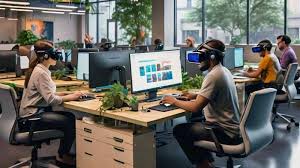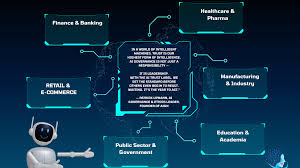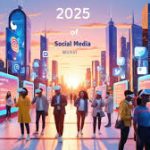The nature of work has changed dramatically in the past few years, and 2025 stands as a turning point. What started as a temporary shift during the COVID-19 pandemic has now evolved into a global rethinking of how, where, and even whether humans work. Remote work, hybrid models, and automation are no longer experiments—they are permanent fixtures reshaping the global workforce.
This article explores how remote and hybrid work models are redefining office culture, the growing influence of artificial intelligence and robotics on employment, and the long-term implications for workers, businesses, and governments worldwide.
The Rise of Remote Work
Remote work has become a standard practice rather than a niche option. Many companies realized that employees could remain productive without being tied to an office.
-
Flexibility as a Priority: Workers now seek jobs that offer freedom to work from anywhere. Surveys show that flexibility ranks higher than salary for many employees.
-
Global Hiring: Employers can recruit talent from across the world, increasing diversity and reducing labor costs.
-
Digital Tools: Platforms like Zoom, Slack, and Microsoft Teams have matured into essential work infrastructure.
However, remote work also brings challenges, including isolation, blurred boundaries between work and personal life, and cybersecurity risks.
Hybrid Work: The Middle Ground
Hybrid models have emerged as a balance between in-office and remote work. In 2025, most multinational companies operate on a hybrid basis.
-
Office as a Collaboration Hub: Physical offices are being redesigned as spaces for brainstorming and teamwork rather than daily desk work.
-
Flex Schedules: Employees split time between home and office, often deciding their own balance.
-
Increased Productivity: Studies suggest hybrid workers report higher satisfaction and lower burnout rates compared to fully remote employees.
The hybrid model provides flexibility while maintaining a sense of company culture. Yet, it risks creating two classes of workers—those more visible in the office and those less noticed working remotely.
Automation and AI in the Workplace
Perhaps the biggest transformation in 2025 is the acceleration of automation. Artificial Intelligence, robotics, and machine learning are now central to workplace operations.
-
Routine Jobs Replaced: Roles in customer service, data entry, and logistics are increasingly automated.
-
AI as a Collaborator: Instead of replacing workers entirely, AI often acts as a “digital coworker,” handling repetitive tasks so humans can focus on creativity and problem-solving.
-
Industry Disruption: Sectors like healthcare, manufacturing, and finance are heavily adopting automation. For instance, AI doctors can now assist in diagnostics, and robotic warehouses streamline logistics.
Automation has increased efficiency but sparked fears of job losses, especially in developing economies where low-skill labor dominates.
The Human Element in a Digital World
Despite technological advances, human skills remain irreplaceable. Creativity, emotional intelligence, and leadership cannot be easily automated.
-
Soft Skills in Demand: Employers now prioritize adaptability, communication, and collaboration.
-
Upskilling and Reskilling: Workers must continuously learn new skills to remain relevant in an AI-driven workplace.
-
Ethical Decision-Making: Humans are still needed to oversee AI systems, ensuring fairness and accountability.
The future of work is not just about machines—it’s about how humans and technology coexist.
Global Variations in Work Models
The shift toward remote, hybrid, and automated work looks different across the world.
-
United States: Hybrid work dominates, with tech hubs like Silicon Valley pioneering AI-driven workflows.
-
Europe: Strong labor protections have led to structured hybrid models with strict rules on working hours and employee rights.
-
Asia: Countries like India and China are leveraging automation while also embracing remote outsourcing for global firms.
-
Africa: Remote work is expanding opportunities, but limited digital infrastructure creates challenges.
Each region balances its economic, cultural, and technological realities in shaping the future of work.
Economic and Social Implications
The transformation of work has wide-ranging consequences:
-
Urban Development: Cities once dependent on daily commuters are rethinking infrastructure, with reduced demand for office space.
-
Global Inequality: Wealthier nations benefit from advanced automation, while poorer regions risk being left behind.
-
Work-Life Balance: Remote and hybrid models improve balance for some, but automation-driven job insecurity creates stress for others.
-
Policy and Governance: Governments must craft new labor laws, tax structures, and social safety nets to address these shifts.
The balance between opportunity and disruption will determine whether this new work era benefits society as a whole.
The Future: Remote, Hybrid, or Automated?
Experts predict a blended future:
-
Remote work will remain dominant for knowledge-based industries.
-
Hybrid models will become the standard for global corporations.
-
Automation will continue to replace some jobs but also create new ones in tech, AI management, and digital services.
The ultimate outcome depends on how well workers adapt, how responsibly businesses implement technology, and how effectively governments regulate.
FAQs
Will remote work replace offices completely?
Not entirely. Offices will still exist, but they will function more as collaborative hubs than daily workplaces.
Which jobs are most at risk of automation?
Routine, repetitive roles such as data entry, basic accounting, customer service, and logistics are most vulnerable.
How can workers prepare for the future of work?
By continuously upskilling in areas like digital literacy, AI management, and soft skills such as creativity and collaboration.
Which industries benefit most from hybrid work models?
Tech, finance, and consulting thrive in hybrid setups, while sectors like healthcare and manufacturing require more physical presence.
How will governments respond to automation-driven job loss?
Many are exploring policies like universal basic income (UBI), expanded social safety nets, and incentives for reskilling programs.
Conclusion
The future of work in 2025 is not a single path but a convergence of remote flexibility, hybrid collaboration, and automation-driven efficiency. While technology continues to reshape employment, human adaptability remains the most critical factor.
Remote and hybrid work have empowered employees with greater freedom, while automation has introduced both productivity gains and employment challenges. To ensure a fair future, businesses, workers, and governments must collaborate in creating systems that balance efficiency with equity.
Ultimately, the future of work is not about machines replacing humans—it is about humans redefining their roles in a rapidly changing world. Those who embrace learning, adaptability, and innovation will thrive in the workplaces of tomorrow.












